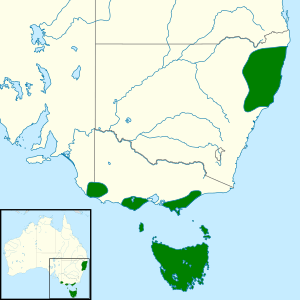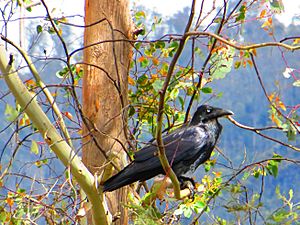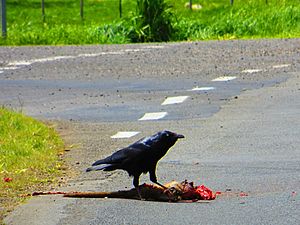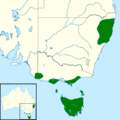Forest raven facts for kids
Quick facts for kids Forest raven |
|
|---|---|
 |
|
| With roadkill, Collinsvale, Tasmania | |
| Conservation status | |
| Scientific classification | |
| Genus: |
Corvus
|
| Species: |
tasmanicus
|
 |
|
| Distribution map | |
| Synonyms | |
|
Corvus australis Gmelin, 1788 |
|
The forest raven (Corvus tasmanicus), also known as the Tasmanian raven, is a type of passerine bird. It belongs to the Corvidae family, which includes crows and jays. This bird is native to Tasmania and parts of southern Victoria, like Wilsons Promontory. You can also find them in some areas of New South Wales, including Dorrigo.
Forest ravens are about 50 to 53 centimeters (20-21 inches) long. They are completely black, including their feathers, beak, and legs. Like other ravens in Australia, their black feathers have grey bases. Adult forest ravens have white eyes, while younger birds have dark brown or hazel eyes with a blue ring.
These ravens live in many different places in Tasmania. On mainland Australia, they prefer forests. They build their nests high in trees during spring and summer. Forest ravens eat many different things, like plants, animals, and even food waste from towns. They are known to eat roadkill. Farmers in Tasmania sometimes blame them for harming lambs and poultry. Forest ravens usually stay in one place and often mate for life.
Contents
About the Forest Raven
What's in a Name?
The forest raven was first described as a unique type of bird in 1912 by Gregory Mathews. Its scientific name, Corvus tasmanicus, comes from Tasmania, where it is commonly found. In 1970, scientist Ian Rowley officially named it the forest raven. He noticed it was much larger than its closest relative, the little raven.
For a long time, all crows and ravens in Australia were just called "crows." It was hard to tell them apart. Scientists later figured out there were different species.
Family Tree of Ravens and Crows
Scientists have studied the DNA of Australian ravens and crows. They found that the three raven species (forest, little, and Australian ravens) are closely related. The two crow species (Bismarck and Torresian crows) are also related to each other, but not as closely to the ravens.
Here's how scientists think they are related:
| Australasian corvids | ||||||||||||||||||||||||||||||||||||
|
||||||||||||||||||||||||||||||||||||
| Based on Jønsson et al. 2012 |
}}
Scientists believe that the first raven and crow ancestors came to Australia from the north. Then, they split into different groups as the climate changed. Forest ravens likely stayed in forested areas.
Appearance and Sounds

What They Look Like
The forest raven is the biggest of Australia's corvids. It measures about 50 to 53 centimeters (20-21 inches) long. Its wingspan can be up to 113 centimeters (44 inches). It weighs around 650 grams (1.4 pounds).
Their feathers are completely glossy black. In sunlight, you might see a blue or green shine on their upper parts. Their wings are long and wide. The tail is rounded or wedge-shaped. Forest ravens have a strong, heavy beak. The top part of their beak is covered with stiff bristles. Their mouth, tongue, legs, and feet are all black.
Both male and female forest ravens look the same. Males are usually a bit bigger. You can tell a forest raven from a crow by looking at the base of its feathers. Raven feathers have grey bases, while crow feathers have white bases. This is usually only seen if their feathers are ruffled by the wind.
Young Ravens
Young forest ravens (under one year old) have a shorter, thinner beak. It is dark grey with some pink at the base. Their feathers are softer and can look brownish. They usually don't have the shiny look of adult birds.
Eye color changes as they grow:
- Baby ravens (up to 4 months old) have blue-grey eyes.
- Young birds (4 to 14 months old) have brown eyes.
- Older young birds (up to almost 3 years old) have hazel eyes with blue rings around the pupil.
What They Sound Like
The sound a forest raven makes is often the best way to identify it. They have a deep, husky call that sounds like "korr-korr-korr-korr". The last note is long, similar to the Australian raven. They also make a barking sound when they are alarmed. Young ravens have higher-pitched calls than adults.
Where They Live and How They Live
Homes and Habitats
The forest raven is the only type of corvid that lives permanently in Tasmania. It is found all over the state. On mainland Australia, there are three groups in southern Victoria. There are also two separate groups in northern New South Wales. One group lives near the coast, and another lives in the mountains.
In Tasmania, forest ravens live in many places. These include woods, forests, mountains, coastal areas, farms, and even near towns and cities. On mainland Australia, they mostly stick to forests. They seem to be spreading into towns more, possibly because of more roadkill from cars.
Forest ravens can fly long distances. They have been seen flying from Tasmania to islands far offshore. They even travel across the Bass Strait.
Staying Safe
The forest raven is listed as Least Concern on the IUCN Red List. This means it is not currently in danger of extinction. Even though their numbers have slightly decreased, it's not enough to be worried about. However, the populations in northern New South Wales are considered Near Threatened.
Life and Habits
Daily Life
Forest ravens usually stay in one place and defend their territory. A single pair and their young will live in an area all year round. Other ravens might visit this area to find food. Young ravens that are not yet breeding form flocks and move around.
When on the ground, forest ravens usually walk. They might hop if they are in a hurry, like when avoiding a car.
Reproduction and Family Life
Forest ravens start breeding when they are at least three years old. They form pairs that stay together for life. They breed later in Tasmania than on mainland Australia. In New South Wales, eggs are laid from July to September. In Tasmania, the breeding season is from August to January.
They usually build their nests in tall trees, often eucalyptus trees. The nest is shaped like a bowl and made of twigs. They line it with soft materials like leaves, wool, grass, or feathers. Sometimes, they fix up old nests from previous years.
What They Eat
The forest raven is an omnivore, meaning it eats both plants and animals. It eats more meat than smaller corvids. Their diet includes insects, dead animals (carrion), fruit, grain, and earthworms. They have even been seen attacking and eating small birds like the little penguin. A lot of their food comes from areas near water.
Forest ravens often look for food in pairs or small groups. But if there's a lot of food, like a large dead animal or a rubbish dump, many ravens might gather. They are attracted to places where people leave food, like picnic areas and roadsides. They sometimes hunt with other types of ravens and crows.
They usually look for food in the morning or late afternoon. They rest during the hottest part of the day. They find food mainly on the ground, often turning over objects with their beaks. They also fly low over marshlands or beaches to spot food. They have been known to steal eggs and young birds from other birds' nests.
Forest ravens sometimes hide food to eat later. They might store it in trees to keep it safe from other animals.
Ravens and Humans
Farmers in Tasmania have sometimes killed forest ravens. They believe the ravens harm their livestock and fruit crops. However, studies show that ravens rarely kill healthy lambs. They are more likely to eat afterbirth or sick animals. So, their bad reputation might not be fair. Forest ravens actually help by cleaning up dead animals and eating insect pests. Even though they like roadkill, they are rarely hit by cars themselves.
Images for kids
See also
 In Spanish: Cuervo de Tasmania para niños
In Spanish: Cuervo de Tasmania para niños





